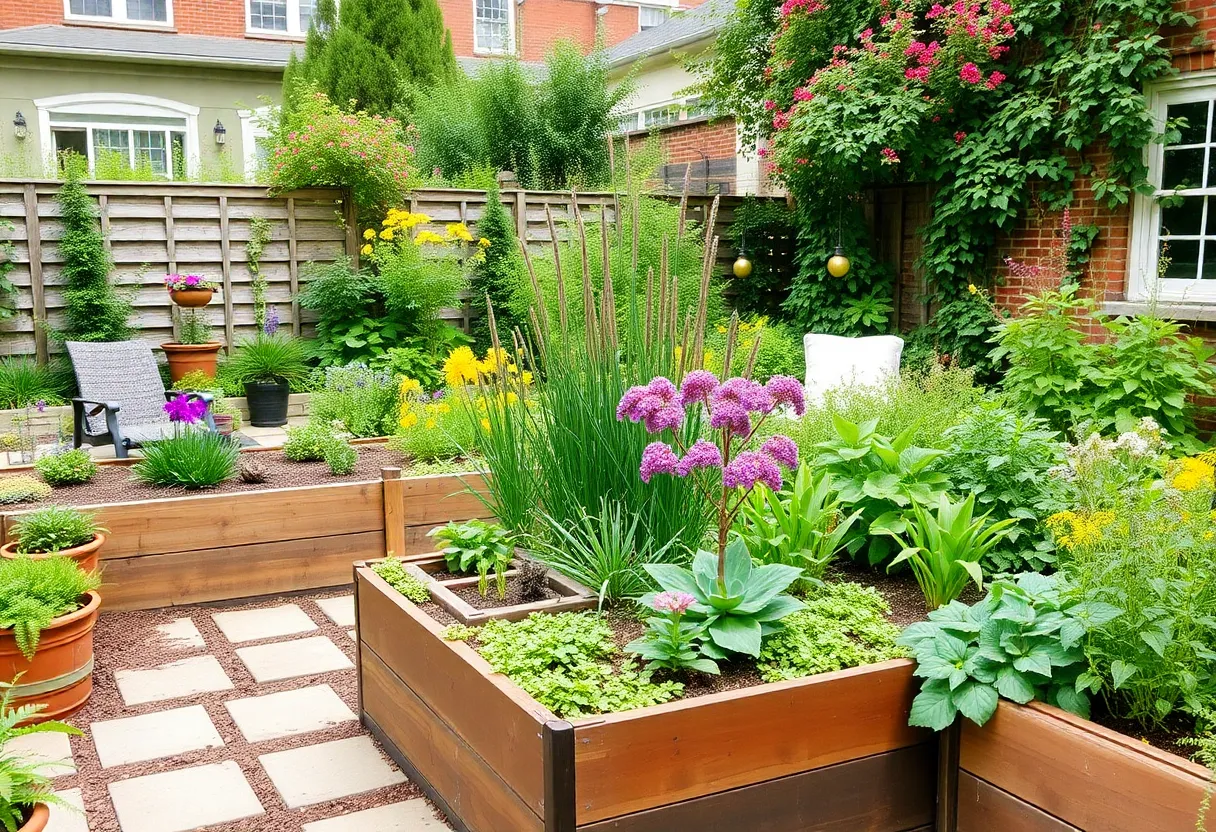10 Inspiring Garden Makeover Ideas to Revitalize Your Philadelphia Yard
Revitalizing an outdoor space requires strategic planning and thoughtful design. A well-executed garden makeover not only enhances aesthetic appeal but also increases functionality and sustainability. Below are ten meticulously curated ideas that will help transform your Philadelphia yard into a lively, eco-friendly, and enjoyable environment.
1. Embrace Native Plantings
Prioritizing native plantings is one of the most sustainable strategies for a successful garden makeover. Native plants are adapted to local climate conditions, which translates to reduced maintenance requirements and increased resilience. They also promote biodiversity by providing habitat and food for local wildlife. Consider incorporating species like Black-eyed Susans, which bloom with vibrant yellow flowers; Purple Coneflower, valued for its long-lasting blooms and drought tolerance; and Wild Bergamot, which attracts pollinators such as bees and butterflies. Utilizing native flora results in a lower need for chemical interventions, fostering a healthier ecosystem.
2. Create a Pollinator-Friendly Habitat
Designing a garden that supports pollinators is vital for promoting biodiversity. Pollinator spaces attract essential species like bees, butterflies, and hummingbirds. Incorporate plants such as Butterfly Milkweed, which serves as a larval host for monarch butterflies, Joe-Pye Weed, known for its large, fragrant clusters that attract butterflies, and Bee Balm, which provides nectar abundance. Strategic planting ensures continuous bloom cycles throughout the growing season, offering vital resources for pollinators. Additionally, incorporating shallow water sources and avoiding pesticide use amplify habitat benefits.
3. Install Raised Garden Beds
Raised garden beds significantly improve soil quality and drainage, enabling healthier plant growth. They also facilitate better soil management and reduce weed intrusion. These beds can be customized in height, making gardening accessible for individuals with physical limitations. Constructed from materials like pressure-treated wood, composite composites, or even stone, they offer a cost-effective way to foster productive vegetable gardens or ornamental displays. Elevated planting also minimizes soil compaction and erosion, especially during heavy rains common in the Philadelphia climate.
4. Incorporate Vertical Gardening
Maximize limited space by adopting vertical gardening solutions. Installing trellises, wall-mounted planters, or green walls enables the cultivation of climbing plants such as beans, squash, and melons. Vertical gardens are especially suited for smaller yards, patios, or urban settings, providing increased planting area without sacrificing usable ground space. Proper support structures combined with suitable plant selection enhance air circulation and reduce disease risk, ensuring healthier growth in compact environments.
5. Designate a Relaxation Zone
A dedicated relaxation area transforms your garden into a personal sanctuary. Incorporate comfortable seating such as Adirondack chairs or a swing. Elements like an outdoor fireplace or a water feature can elevate the ambiance, creating a tranquil atmosphere. Planning this zone with adequate shade and privacy features ensures it remains a peaceful retreat. Strategically placing this area near flowering plants or shade trees enhances sensory experiences through sights, sounds, and fragrances, fostering relaxation and social gatherings.
6. Implement Sustainable Practices
Eco-conscious gardening practices yield long-term environmental and economic benefits. Use organic fertilizers instead of chemical alternatives to promote soil health. Composting kitchen scraps and garden waste recycles nutrients and reduces landfill contributions. Rainwater harvesting systems, such as rain barrels, provide an efficient watering source, conserving municipal water. Adopting these methods minimizes ecological impact, cuts costs, and results in healthier, more resilient garden systems.
7. Add Decorative Elements
Enhancing visual interest with decorative features lends personality to your garden. Incorporate birdbaths or sculptures that complement the theme of your outdoor space. Wind chimes or hanging lanterns add auditory and visual appeal. These elements serve as focal points and can reflect personal style while creating a layered and inviting landscape. Proper placement and proportionate scale ensure these features contribute to the overall harmony of the garden.
8. Establish a Community Garden
Forming a community garden encourages neighborhood engagement and shared responsibility. Such gardens foster social bonds and promote communal efforts towards sustainability. They can provide access to fresh produce for local residents and support educational activities on sustainable practices. Structuring these spaces with designated plots, shared tools, and composting areas enhances functionality and cooperativity, ultimately strengthening community ties.
9. Utilize Hardscaping Features
Introducing hardscaping elements such as stone pathways, patios, and retaining walls creates structure and defines different zones. These features improve accessibility, making your garden safer and more navigable. Stringing together functional areas with durable materials contributes to the longevity of the landscape design. For example, a well-designed stone pathway can guide visitors through flower beds, while a patio offers a versatile space for gatherings or outdoor dining.
10. Plan for Seasonal Interest
Ensuring year-round visual appeal requires selecting plants that bloom at different times. Incorporate evergreens to provide structure during winter months. Deciduous trees with striking fall foliage add seasonal color, while perennial flowers like daylilies and peonies flower at various times throughout spring and summer. This deliberate planting strategy maintains visual interest, supports diverse wildlife, and provides ongoing engagement with the garden across all seasons.
Conclusion
By integrating these ten ideas, you foster a garden environment that is sustainable, visually appealing, and highly functional. Thoughtful design tailored to the Philadelphia climate and ecosystem maximizes outdoor enjoyment and ecological contribution. Each element—whether native plantings, hardscaping, or social spaces—plays a role in creating a yard that reflects personal style while supporting local biodiversity and environmental health.
FAQs
How can native plants improve my garden?
Native plants are adapted to local climate and soil conditions, which reduces watering and maintenance needs. They also support local wildlife by providing essential habitat and food sources, fostering a more resilient and balanced ecosystem.
What are the benefits of vertical gardening?
Vertical gardening maximizes small or limited space, allowing for increased plant variety and productivity. It enhances aesthetics, improves air circulation, and makes gardening more accessible, especially for individuals with physical limitations.
What sustainable practices can I incorporate into my garden?
Implementing organic fertilizers, composting organic waste, using rainwater harvesting systems, and avoiding chemical pesticides are effective ways to create an eco-friendly garden that promotes soil health and conserves water.
How do hardscaping features benefit my garden?
Hardscaping elements such as pathways, patios, and retaining walls add structure, define outdoor spaces, improve accessibility, and enhance aesthetic appeal. They also increase the durability and longevity of your garden layout.
Key Features of an Effective Garden Makeover
| Feature | Description | Benefit |
|---|---|---|
| Native Plantings | Plants adapted to local climate and soil | Lower maintenance, supports biodiversity |
| Pollinator Habitat | Gardens designed to attract bees, butterflies, hummingbirds | Enhanced ecosystem health, increased pollination |
| Raised Beds | Elevated planting structures | Improved soil drainage, accessibility |
| Vertical Gardening | Climbing plants, wall-mounted planters | Maximizes small spaces, adds visual interest |
| Relaxation Zone | Dedicated seating and tranquil features | Personal sanctuary for relaxation or socializing |
| Sustainable Practices | Organic fertilizers, composting, rainwater harvesting | Eco-friendly, cost-effective |
| Decorative Elements | Birdbaths, sculptures, wind chimes | Enhanced visual appeal |
| Community Garden | Shared space with neighbors | Fosters social ties, promotes local food |
| Hardscaping | Paths, patios, retaining walls | Structure, accessibility, durability |
| Seasonal Interest | Year-round plant selection | Continual visual engagement |
Author: STAFF HERE PHILADELPHIA WRITER
The PHILADELPHIA STAFF WRITER represents the experienced team at HEREPhiladelphia.com, your go-to source for actionable local news and information in Philadelphia, Philadelphia County, and beyond. Specializing in "news you can use," we cover essential topics like product reviews for personal and business needs, local business directories, politics, real estate trends, neighborhood insights, and state news affecting the area—with deep expertise drawn from years of dedicated reporting and strong community input, including local press releases and business updates. We deliver top reporting on high-value events such as Mummers Parade, Philadelphia Flower Show, and Thanksgiving Day Parade. Our coverage extends to key organizations like the Greater Philadelphia Chamber of Commerce and United Way of Greater Philadelphia, plus leading businesses in telecommunications, food services, and healthcare that power the local economy such as Comcast, Aramark, and Children's Hospital of Philadelphia. As part of the broader HERE network, we provide comprehensive, credible insights into Pennsylvania's dynamic landscape.





